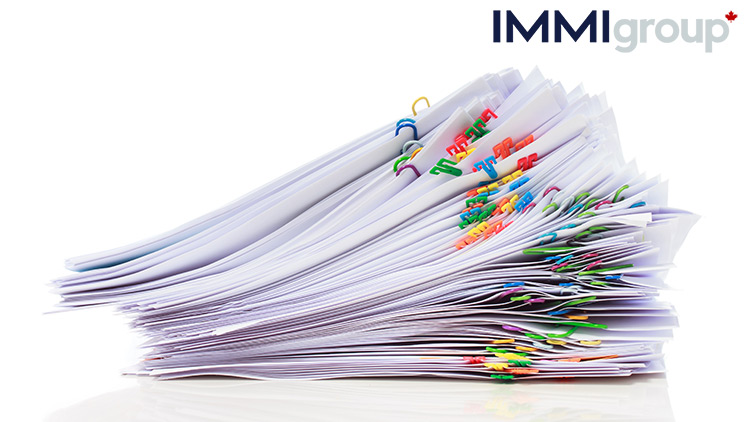Putting Your Sponsorship Application Together

As we’ve mentioned more than a few times now, your Document Checklist (IMM 5533) will be a key guide throughout your application process. You should print the checklist and check off each form after you have successfully completed it as well as each supporting document once it has been obtained and if necessary translated and certified.
Once you’ve filled out all the forms and assembled all the documents listed in the previous chapters, it’s a good time to review your application and check for mistakes – the kind that could cause IRCC to return your application and waste a lot of time, money, and effort.
So let’s do a quick review of important things to check for:
Reviewing Your Sponsorship Application
- Using an out-of-date version of an IRCC form.
- Not understanding a term – like dependents, for example – and answering a question incorrectly.
- Leaving a question unanswered. Always answer the question – use N/A for not applicable but do NOT leave it blank.
- Mixing up who is the Sponsor and who is the Principal Applicant. You will have to redo most forms if you get this wrong.
- Not knowing key IRCC terminology. For example, do you know that these terms mean?
- Biometrics
- Conjugal partner
- Dependent children
- Serious criminality
- Incomplete or unacceptable supporting documents. For example: marriage certificates yes, marriage licenses no.
- Forgetting to provide any documents in the country-specific requirements.
- Inappropriate wedding or other photographs of the couple that are unclear and do not have captions stating who is in the photo and where and when it was taken, for example.
- Who needs to give biometrics and who is exempt? Do you know?
- What kind of doctor is acceptable for a medical examination? Do you know?
- Which class of sponsorship should you submit your application under? Why?
- A poorly written Spousal Sponsorship Letter will actually set you back. Would like to know the secret to writing a strong Spousal Sponsorship Letter?
- Should the principal applicant apply for a visitor visa while you wait for your sponsorship application to be processed?
- When can you appeal a failed sponsorship application? Inland or Outland? Do you know?
- Are you ready for the interview as principal applicant?
- If the Sponsor and the Principal Applicant have had a child together, is that child a Canadian citizen and doesn’t need to be sponsored? Do you know?
- If the principal applicant lists the sponsor’s address in Canada as their mailing address, that makes the sponsor their representative and they have to complete a Use of a Representative form (IMM 5476) listing you, the sponsor, as their representative.
Check to make sure you have dated and signed every form or document that requires your – both the Sponsor and the Principal Applicant – signature.
Any missing signatures will result in your application being sent back to you.
- Check every section of every form to ensure that the correct person has signed and dated it.
- This especially applies in the case of dependent children who are minors (under 18 years of age) for whom you must sign the forms.
We recommend you fill out the forms on your computer (electronically) to ensure that email addresses are clearly legible. It’s a good idea to review your email addresses to ensure they are accurate, especially the email address you provide in the IMM 0008 which will be used as your contact for any communication with IRCC.
Assembling Your Sponsorship Application
Do NOT use the following in your application:
- Staples to attach forms or documents,
- Binders to enclose the application,
- plastic sleeves to protect forms or photos,
- Folders to enclose sections of your application, or
- Photo albums to submit your photos.
All of these ways of organizing your application actually make it harder for IRCC personnel to review your application.
You CAN use the following to attach photos, however:
- Paper clips to attach pages of forms to each other, to attach supporting documents, and large paper clips to combine whole sections or
- Elastic bands to keep everything together.
When you put your application package together, you need to place the documents in the following order:
- Your Summary Letter (see the next chapter)
- Your document checklist printed out at the top
- The open work permit application form & supporting documents – if applicable
- Any barcode pages that you have been required to print.:
- Some forms have a Validate button that you must click to check that the form has been correctly filled out (otherwise the missing or incorrect parts will be highlighted by a red square around the fields (boxes) that have to be filled out).
- Forms that have a validate button include the following:
- IMM 1344 – Application to Sponsor, Sponsorship Agreement, & Undertaking
- IMM 0008 – Generic Application form for Canada
- eIMM 5669 – Schedule A
- Forms IMM 1344 and IMM 0008 will produce a Barcode Page after you press the Validate Button (eIMM 5669 will not produce a barcode page after you click validate)
- All supporting documents in the order they are listed in the document checklist (IMM 5533).
Now that you have everything assembled, you can write the summary letter that will be the first thing in your application.
Why use us?
- We’re accurate. You can relax, knowing your application is right.
- We’re alert. We’ll monitor your application through every step of the process.
- We’re advocates. We’ll deal with the government and handle all correspondence on your behalf.